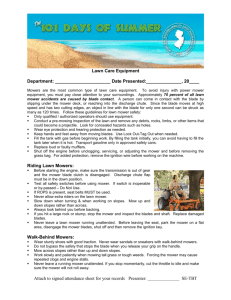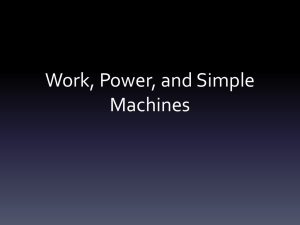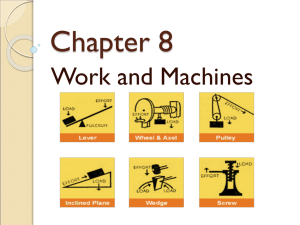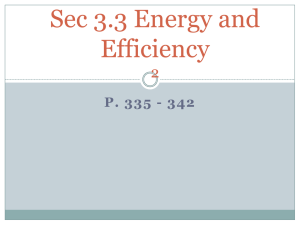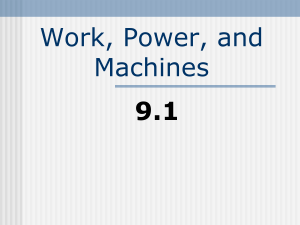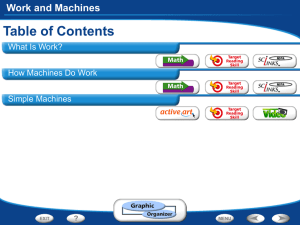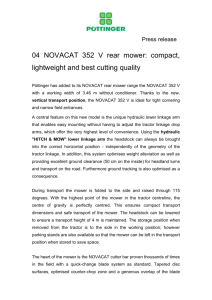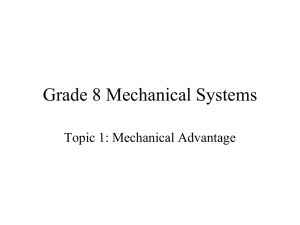Chapter 12 Notes
advertisement
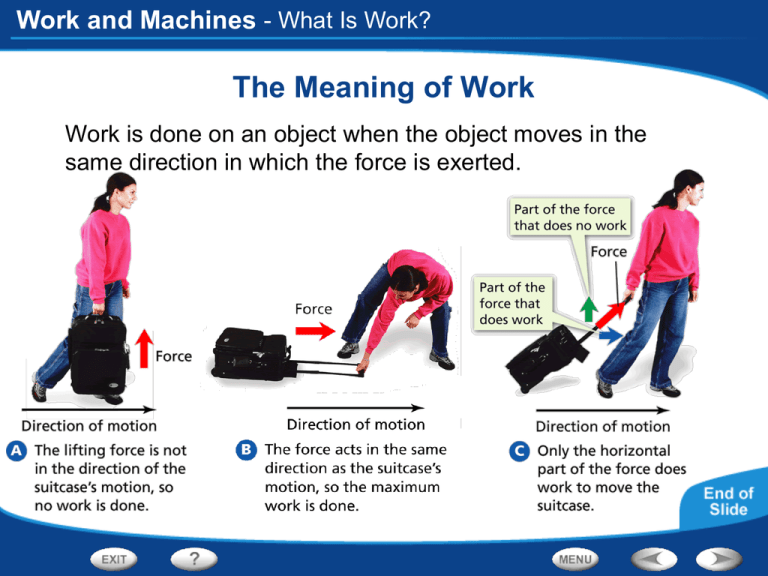
Work and Machines - What Is Work? The Meaning of Work Work is done on an object when the object moves in the same direction in which the force is exerted. Work and Machines Work Work = Force x Distance A student drags a backpack 10 meters by applying a force of 50 Newtons. Calculate the work done by the student. Work and Machines Power Power = Work Time If the student in the previous problem drags the backpack over the period of 20 seconds, calculate the power required If the backpack is dragged over the period of 10 seconds, calculate the power reqiuired. Work and Machines How Machines Do Work Machine • A machine is a device that allows you to do work in an easier or more effective way • A machine makes work easier by changing one or more of three things 1.The force you exert 2.The distance over which you exert the force 3.The direction over which you exert the force • Input Force: The force you exert • Output force: The force the machine exerts Work and Machines - What Is Work? Calculating Power A tow truck exerts a force of 11,000 N to pull a car out of a ditch. It moves the car a distance of 5 m in 25 seconds. What is the power of the tow truck? Plan and Solve What quantity are you trying to calculate? The Power (P) the tow truck uses to pull the car = __ What formula contains the given quantities and the unknown quantity? Power = (Force X Distance)/Time Perform the calculation. Power = (11,000 N X 5.0 m)/25 s Power = (55,000 N•m)/25 s or 55,000 J/25 s Power = 2,200 J/s = 2,200 W Work and Machines - What Is Work? Calculating Power Practice Problem A crane lifts an 8,000-N beam 75 m to the top of a building in 30 seconds. What is the crane’s power? 20,000 W or 20 kW Work and Machines - How Machines Do Work Input and Output Work The amount of input work done by the gardener equals the amount of output work done by the shovel. Work and Machines - How Machines Do Work Screwdriver or Faucet Work and Machines Mechanical Advantage Mechanical Advantage = Output Force Input Force See example pg. 416 Work and Machines - How Machines Do Work Mechanical Advantage The input force and output force for three different ramps are shown in the graph. Work and Machines - How Machines Do Work Mechanical Advantage Reading Graphs: What variable is plotted on the horizontal axis? Input force Work and Machines - How Machines Do Work Mechanical Advantage Interpreting Data: If an 80-N input force is exerted on Ramp 2, what is the output force? 400 N Work and Machines - How Machines Do Work Mechanical Advantage Drawing Conclusions: Why does the slope represent each ramp’s mechanical advantage? Which ramp has the greatest mechanical advantage? The slope of each ramp’s graph equals the change in output force divided by the change in input force. This is the formula for mechanical advantage. Ramp 1 has the greatest mechanical advantage. Work and Machines - How Machines Do Work Calculating Efficiency You do 250,000 J of work to cut a lawn with a hand mower. If the work done by the mower is 200,000 J, what is the efficiency of the lawn mower? Read and Understand What information have you been given? Input Work (Winput) = 250,000 J Output Work (Woutput) = 200,000 J Work and Machines - How Machines Do Work Calculating Efficiency You do 250,000 J of work to cut a lawn with a hand mower. If the work done by the mower is 200,000 J, what is the efficiency of the lawn mower? Plan and Solve What quantity are you trying to calculate? The efficiency of the lawn mower = __ What formula contains the given quantities and the unknown quantity? Efficiency = Output work/Input work X 100% Perform the calculation. Efficiency = 200,000 J/250,000 J X 100% Efficiency = 0.8 X 100% = 80% The efficiency of the lawn mower is 80 percent. Work and Machines - How Machines Do Work Calculating Efficiency You do 250,000 J of work to cut a lawn with a hand mower. If the work done by the mower is 200,000 J, what is the efficiency of the lawn mower? Look Back and Check Does your answer make sense? An efficiency of 80 percent means that 80 out of every 100 J of work went into cutting the lawn. This answer makes sense because most of the input work is converted to output work. Work and Machines - How Machines Do Work Calculating Efficiency Practice Problem You do 20 J of work while using a hammer. The hammer does 18 J of work on a nail. What is the efficiency of the hammer? 90% Work and Machines - How Machines Do Work Calculating Efficiency Practice Problem Suppose you left your lawn mower outdoors all winter. Now it’s rusty. Of your 250,000 J of work, only 100,000 J go to cutting the lawn. What is the efficiency of the lawn mower now? 40% Work and Machines - Simple Machines Inclined Plane An inclined plane is a flat, sloped surface. Work and Machines - Simple Machines Wedge A wedge is a device that is thick at one end and tapers to a thin edge at the other end. Work and Machines - Simple Machines Screws A screw can be thought of as an inclined plane wrapped around a cylinder. Work and Machines - Simple Machines Levers A lever is a ridged bar that is free to pivot, or rotate, on a fixed point. Work and Machines - Simple Machines Levers Levers are classified according to the location of the fulcrum relative to the input and output forces. Work and Machines - Simple Machines Wheel and Axle A wheel and axle is a simple machine made of two circular or cylindrical objects fastened together that rotate about a common axis. Work and Machines - Simple Machines Wheel and Axle You can find the ideal mechanical advantage of a wheel and axle by dividing the radius of the wheel by the radius of the axle. Work and Machines - Simple Machines Pulley A pulley is a simple machine made of a grooved wheel with a rope or cable wrapped around it. Work and Machines - Simple Machines Types of Pulleys Activity Click the Active Art button to open a browser window and access Active Art about types of pulleys. Work and Machines - Simple Machines Simple Machines in the Body Most of the machines in your body are levers that consist of bones and muscles. Work and Machines - Simple Machines Compound Machines A compound machine is a machine that utilizes two or more simple machines. Work and Machines - How Machines Do Work Identifying Main Ideas As you read the section “What Is a Machine?” write the main idea in a graphic organizer like the one below. Then write three supporting details that further explain the main idea. Main Idea The mechanical advantage of a machine helps by… Detail Detail Detail changing the amount of force you exert changing the distance over which you exert your force changing the direction of the force Work and Machines - How Machines Do Work Links on Mechanical Efficiency Click the SciLinks button for links on mechanical efficiency. Work and Machines End of Section: How Machines Do Work Work and Machines - Simple Machines Previewing Visuals Before you read, preview Figure 17. Then write two questions that you have about the diagram in a graphic organizer like the one below. As you read, answer your questions. Three Classes of Levers Q. What are the three classes of levers? A. The three classes of levers are first-class levers, second-class levers, and third-class levers. Q. How do the three classes of levers differ? A. They differ in the position of the fulcrum, input force, and output force. Work and Machines - Simple Machines Levers Click the Video button to watch a movie about levers. Work and Machines - Simple Machines Pulleys Click the Video button to watch a movie about pulleys. Work and Machines End of Section: Simple Machines Work and Machines Graphic Organizer Simple Machine Mechanical Advantage Inclined plane Length of incline ÷ Height of incline Ramp Wedge Length of wedge ÷ Width of wedge Ax Screw Length around threads ÷ Length of screw Screw Lever Distance from fulcrum to input force ÷ Distance from fulcrum to output force Seesaw Wheel and axle Radius of wheel ÷ Radius of axle Pulley Example Screwdriver Number of sections of supporting rope Flagpole Work and Machines End of Section: Graphic Organizer

